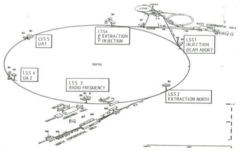 | |
| Key SppS Experiments | |
|---|---|
| UA1 | Underground Area 1 |
| UA2 | Underground Area 2 |
| UA4 | Underground Area 4 |
| UA5 | Underground Area 5 |
| SppS pre-accelerators | |
| PS | Proton Synchrotron |
| AA | Antiproton Accumulator |
The Antiproton Accumulator (AA) was an infrastructure connected to the Proton–Antiproton Collider (SppS) – a modification of the Super Proton Synchrotron (SPS) – at CERN.[1][2] The AA was built in 1979 and 1980, for the production and accumulation of antiprotons.[3][4] In the SppS the antiprotons were made to collide with protons, achieving collisions at a center of mass energy of app. 540 GeV (later raised to 630 GeV and finally, in a pulsed mode, to 900 GeV). Several experiments recorded data from the collisions, most notably the UA1 and UA2 experiment, where the W and Z bosons were discovered in 1983.
The concept of the project was developed and promoted by C. Rubbia, for which he received the Nobel prize in 1984.[5] He shared the prize with Simon van der Meer, whose invention of the method of stochastic cooling made large scale production of antiprotons possible for the first time.
- ^ Billinge, R.; Crowley-Milling, M. C. (1979). "The CERN Proton-Antiproton Colliding Beam Facilities" (PDF). IEEE Transactions on Nuclear Science. 26 (3): 2974–2977. Bibcode:1979ITNS...26.2974B. doi:10.1109/TNS.1979.4329913. ISSN 0018-9499. S2CID 33805929.
- ^ Brianti, G. (1983). "Experience with the CERN ppbar complex" (PDF). IEEE Transactions on Nuclear Science. 30 (4): 1950–1956. Bibcode:1983ITNS...30.1950B. doi:10.1109/TNS.1983.4332685. ISSN 0018-9499. S2CID 39013232.
- ^ Koziol, H.; Möhl, D. (2004). "The CERN antiproton collider programme: accelerators and accumulation rings" (PDF). Physics Reports. 403–404: 91–106. Bibcode:2004PhR...403...91K. doi:10.1016/j.physrep.2004.09.001. ISSN 0370-1573.
- ^ Evans, Lyndon; Jones, Eifionydd; Koziol, Heribert (1989). "The CERN ppbar collider". In Di Lella, Luigi; Altarelli, Guido (eds.). Proton-antiproton collider physics. Vol. 4. World Scientific. pp. 1–44. Bibcode:1989ASDHE...4R...1E. doi:10.1142/9789814503242_0001. ISBN 9789971505622.
{{cite book}}:|journal=ignored (help) - ^ "Press Release: The 1984 Nobel Prize in Physics". Nobelprize.org. 17 October 1984. Retrieved 24 July 2017.